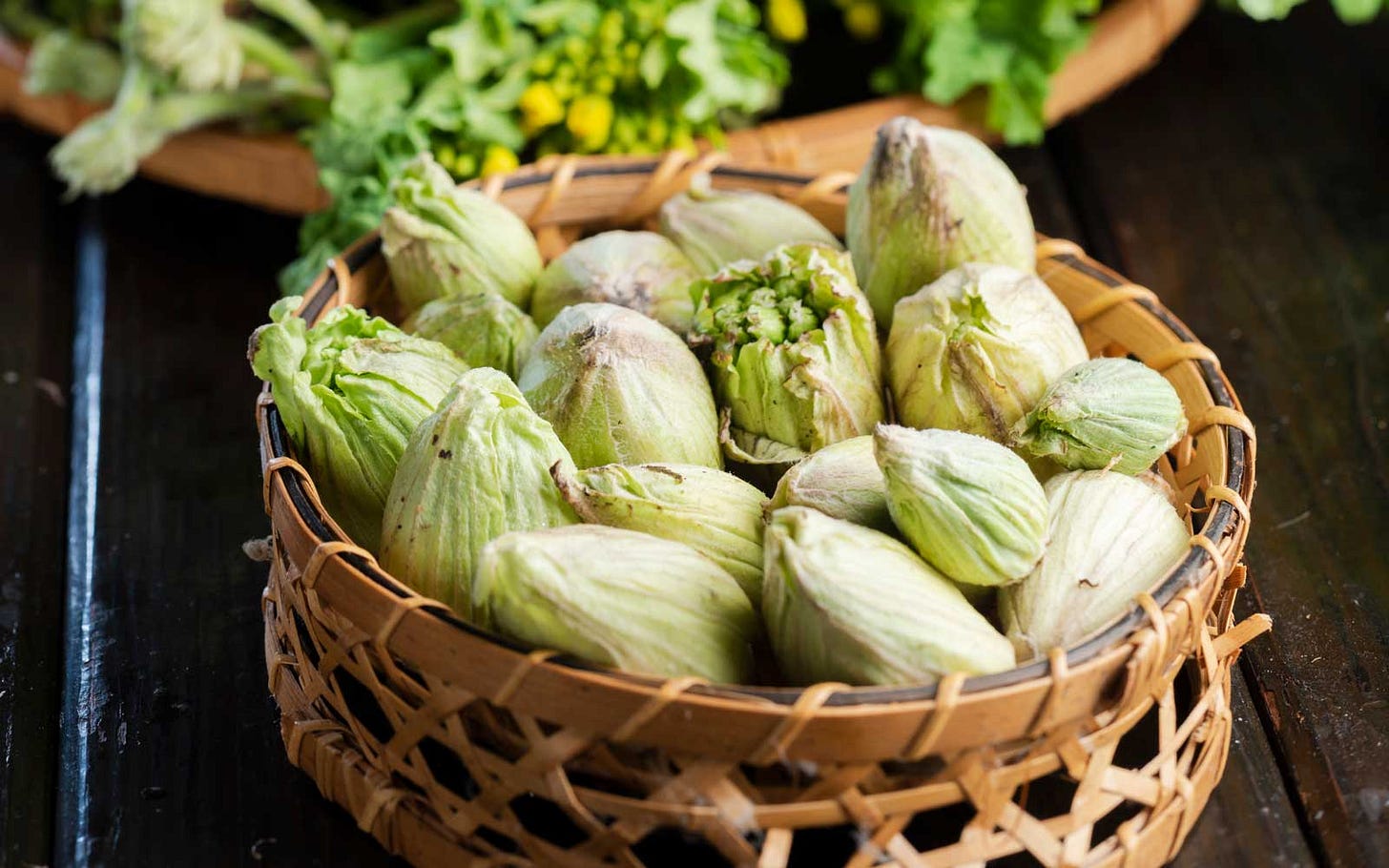January 20 - 24
款冬華
ふきのはなさく
Fuki no hana saku
”Butterbur flowers bud”
One of the most important things in nature, in life in general, is timing. Being in the right place at the right time, saying the wrong thing at the wrong time, when something happens can have a huge impact on how it turns out. For fuki, the key to successful growth lies in being one of the first to flower out of the snow. Likewise, the key to enjoying fuki in a meal is finding it at the perfect time.
Known in English as “butterbur,” fuki is one of the earliest heralds of spring. It will grow to full height and actually flower in March or April, but what pop theirs heads out of the snow here in the middle of the coldest period of the winter season are the young bulb-like shoots, called fuki-no-tō (蕗の薹). It’s these yellow-green shoots that are especially prized and foraged for, leading to the theory that their name comes from the word fuyuki (冬黄), “winter yellow.”
Long believed to have a variety of natural detox-like effects, the main reason it’s enjoyed these days is because the tender buds of its early-blooming flower are very, very tasty. However, once spring begins in true and the flower begins to actually grow, the once delicious fuki-no-tō turn unpleasantly bitter.
Like much of what we as a species have learned through our history, people in Japan seem to have started eating these young shoots after observing bears coming out of hibernation seeking them with specific focus. It’s believed that fuki-no-tō are densely packed with nutrients like Vitamin B1 and are particularly high in calcium, which could improve bone health and bloodflow.
Perhaps it was the bear-worshipping Ainu1, or one of the other indigenous cultures of northern Japan that first took notice of this, given the animals were thought to be gods visiting Earth (and with that amount of power and presence, really how could you not). As it happens, they also had stories associated with the butterbur, which they call kor. It was said that the Korpokkur made their homes underneath the flowers.
The Korpokkur (lit. “butterbur under person”) were a race of small, hidden people in Ainu folklore, similar to gnomes in the West. Friendly, but secretive, the Korpokkur were skilled at fishing and would exchange goods with the Ainu via clandestine drop-offs—up until a young man ambushed one in the middle of the night to try and see them for himself. They haven’t been seen since.


For those of us who are more than a handful of centimeters tall, fuki are mainly used for food. Part of a group of wild-growing edible plants called sansai (山菜, lit. “mountain vegetables”), fuki-no-tō foraged in this season are best enjoyed as freshly fried tempura. In later months, the buds can be marinated in miso, and the stalks can be stewed or pickled.



And this is just the earliest of the sansai. As the year moves into spring and summer, a journey into the mountain forests can reward keen foragers with zenmai (薇, fiddlehead), taranome (楤の芽, angelica tree shoots), and perhaps most famously: take-no-ko (竹の子, bamboo shoots).
Japan’s food culture is one that appreciates seasonality in its flavors, and pulling up fresh roots, shoots, and buds during certain weeks of the year is about as seasonal as it gets. Each sansai has its own time to be enjoyed, which invites a degree of attention and a feeling of anticipation that you wouldn’t get were they available year round.
Speaking of, what else besides fuki-no-tō tempura might we enjoy during this kō, right now?
● Seasonal seafood
akagai, 赤貝, blood clams● Seasonal fruit
kinkan, 金柑, kumquat● Seasonal vegetable
komatsuna, 小松菜, mustard spinach2



Another theory about where fuki got its name is from the word yama-fubuki (山息吹), which means “the breath of the mountain.” The breath in this case is the fresh, invigorating breath of life renewed—the first deep breath upon waking, surfacing from underwater, or leaving the house for the first time after being cooped up for a while.
As the mountains, forests, and soil around us begin to wake back up, the fresh life they carry offers something new to discover—and maybe, if you catch it at the right time, to eat.
See you next kō~
[Images & info courtesy of kurashikata.com, kurashi-no-hotorisya.jp, 543life.com, and Wikipedia except where otherwise noted]
The Ainu have come up quite a bit as of late, but as a people adapted to Japan’s northern territories, they’re well placed to appreciate the winter and live alongside it
Komatsuna is one of many cultivars (purposefully grown varieties) of Brassica rapa, a plant that has also given us Napa cabbage, bok choy, and the turnip
The overall genus Brassica is even more represented on supermarket shelves worldwide, with varieties leading to the vegetables we know as broccoli, Brussels sprouts, kale, rutabaga, and mustard






